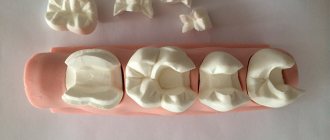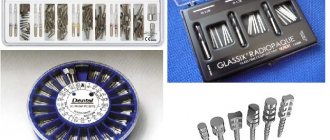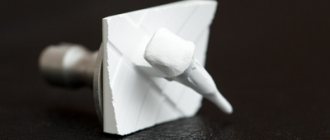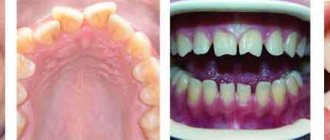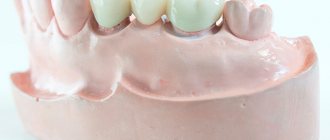If a tooth is destroyed by caries or as a result of injury, it must be restored, otherwise the tooth can be lost, and the absence of even one dental unit in a row is fraught with the most unpleasant consequences for health. For example, due to the absence of a tooth, an incorrect bite may develop, which leads to disruption of the correct process of chewing food and the development of various diseases of the digestive system.
If the tooth is slightly damaged, then most likely the doctor will use a regular, light-curing filling to restore it. But if the damage is significant, it would be more correct to use a stump tab.
Many people do not even know what kind of structure this is - a stump tab and for what purpose it is used by dentists. Meanwhile, the use of stump inlays makes it possible to successfully restore teeth that at first glance seem completely hopeless and must be removed.
In the article we will tell you in detail about what stump inlays are, what types of them exist, and why severely damaged teeth are best restored with inlays, and not with fillings and pins.
Stump tab for a crown: what is it?
Stump inlays in dentistry are a special type of solid-cast structures that are used in the process of restoration of heavily damaged units. If there is significant tissue destruction, a conventional pin cannot be used, since its installation can create excessive stress on the tooth root, which can cause it to crack, which can lead to subsequent removal of the tooth unit. Under such circumstances, the stump tab is installed.
A stump inlay is placed directly into the root canal and this allows you to properly strengthen the tooth in order to subsequently qualitatively restore the unit by installing a crown on it. Externally, the inlay resembles a dental stump that has undergone a grinding procedure and that is why it has the name “stump inlay.”
What is the difference between a pin and a stump inlay?
The fundamental difference between a pin and a stump inlay is that it is placed under a filling. Previously, a similar technique was used to treat severely damaged teeth when it was not possible to install a crown. Subsequently, this method discredited itself with a large number of complications in the form of secondary caries. Moreover, detecting a carious process under an extensive filling on a pin was quite problematic. Often, such treatment led to severe damage to the tooth by caries and, as a consequence, to its removal.
Let's compare the disadvantages and advantages of the pin stump insert and the pin presented below:
Pros and cons of the stump Pros and cons of the pin
tabs
- a tight fit protects the tooth from pathogenic bacteria and the development of secondary caries;
- withstands significant chewing loads;
- has a long service life;
- does not require replacement in case of wear of the artificial crown.
- established in two visits to the doctor;
- involves significant grinding of living tooth tissue;
- costs more than a regular pin.
- costs less than stump inlays;
- installed in one visit;
- involves a smaller volume of preparation of living tooth tissue;
- unable to withstand the usual chewing load, over time the seal on the pin begins to collapse;
- the pin can be installed in only one dental canal;
- a loose fit allows bacteria access into the dental cavity, which provokes the appearance of secondary caries;
- lasts no more than 2-3 years.
Answering the question “Which is better - a stump inlay or a fiberglass pin,” most experts are inclined to favor dental inlays. Considering the unreliability of installing a filling on a pin, such a service can be found extremely rarely in modern dentistry. The most correct option would be to use a stump tab and then install a crown on it. The choice is due to the fact that this microprosthesis not only strengthens the crown, but also protects the tooth from further destruction throughout life.
Indications and contraindications
Indications for the use of a stump inlay as a prosthetic method are severe destruction of dentin, in which its restoration is impossible with composite materials and pins. The crown on the core tab will hold quite firmly and at the same time not exert strong pressure on the root. Stump inlays are also used to create a high-quality foundation for the installation of dental bridges.
However, like any other medical procedure, the installation of stump inlays has not only indications, but also a number of restrictions on its implementation. These restrictions include:
- The patient has an individual allergic reaction to the material used to make the stump insert.
- Identification during examination of cysts and other formations in the root system.
- Excessively thin dental walls, abnormally short roots of the dental unit.
The procedure for installing a stump inlay for periodontitis, as well as poorly treated dental canals, is not carried out. Depending on the individual characteristics of the case, the dentist may offer the patient different types of stump inlays for installation. The cost of the stump tab and tooth restoration services using it will depend on the type of structure.
Stump tab
from 5400 rub. More about prices
We have been working since 1994
we are one of the first to open private dentistry in Moscow
Best materials
only new and modern equipment for dental treatment
Free
consultation with a dentist
Payment options
- cash
- plastic cards
- cashless payments
Doctors' experience
- with great experience
- graduated
- conference participants
Indications for the installation of dental crowns and their types
Restoration of the tooth crown is necessary in case of severe carious damage, as well as in case of large chips, when the production of a filling is ineffective due to the unreliability of fixation of a large volume of filling material. You can put a crown on a tooth if its visible part is completely destroyed, if a healthy root is preserved, and even if the tooth hurts.
For prosthetics, different materials are used that have unique features and advantages. Temporary structures are made of plastic. They perform a protective function after grinding the tooth while the permanent prosthesis is being made.
The cost of installing a crown in Moscow depends on its type. The most affordable option is metal structures. They are strong, durable and wear out slowly, but they look unnatural. Most often used to restore chewing molars.
Metal-ceramic dentures are reliable, have a long service life and a more attractive appearance. Ceramic and porcelain crowns have the highest installation costs. Their main advantages: maximum level of naturalness, perfect imitation of enamel color and long service life. However, such structures are more demanding to maintain. Possible damage due to excessive chewing force.
Types of stump inlays by design
Based on their design, a distinction is made between solid and collapsible stump inlays. Cast core inlays are made by a dental technician in the laboratory and consist of two main parts - a root and a coronal element. Most often, a microprosthesis obtained by casting is used to restore teeth that have 1-2 roots. Collapsible structures are made of metal alloys and are designed for the restoration of dental units with a large number of roots.
This stump tab is equipped with special fixing elements that are pulled out from its base. The legs are needed to secure the structure as firmly as possible in the canal of the tooth, the walls of which have undergone complete destruction. It is impossible to remove a collapsible type stump inlay after its installation.
Which metal is better?
The material for the core inlay must be selected based on many factors, the main one of which is what crowns will be made to restore the teeth.
- Metal or metal-ceramic crowns are made of cobalt-chromium alloy.
- Ceramic crowns are usually made from either a precious alloy (gold-platinum) or the precious alloy is lined with ceramic or zirconium dioxide. The most optimal in terms of its characteristics is a gold inlay for a crown.
- From the point of view of biological inertness, a titanium insert is much more preferable, however, titanium is characterized by fragility.
- Silver-palladium and silver alloys have bactericidal properties. But after using silver inlays for a crown, pigmentation of the gum surrounding the tooth is sometimes observed.
- Chromium-cobalt and chromium-nickel alloys have low shrinkage and high hardness.
»
Types of stump inlays according to production material
Various materials can be used in the manufacture of stump pin inlays. Designs can be produced:
1. Made from zirconium dioxide. A stump inlay made of zirconium dioxide will not only be characterized by increased strength and reliability, but will also have high aesthetics. Most often, zirconium core inlays are used to restore teeth that fall within the smile area.
2. Composite core inlays are created on the basis of a pin and a composite based on dental porcelain (ceramics). This design looks aesthetically pleasing, but it has the lowest strength indicators in comparison with stump spacers made of metal and zirconium.
A separate type of structure is stump inlays made of metal. A variety of metals, as well as their alloys, can be used to create metal inlays. The price of a tooth stump will depend on the type of metals used in the alloy.
Types of tabs
- Ceramic ones are the most popular - they are very aesthetic and quite durable.
- Composite materials have high strength, aesthetics, durability and excellent connection with tooth tissues.
- The best material is zirconium oxide. It looks great and does not shrink over time, but its cost is significantly higher than ceramics and composites.
- Metal ones are usually made for a crown.
Dental inlays are also divided into:
- Restorative. Designed to restore the shape and color of the crown.
- Stump (inlay for crown). Thanks to them, the crown part of the destroyed tooth is restored. Then an artificial crown is installed on such a tab.
Features of the manufacturing and installation process of stump inlays
The process of manufacturing a stump tab and its subsequent installation is divided into several main stages:
1. The dentist carefully prepares both the roots and walls of the tooth for the installation of a core inlay. The tooth is ground down and a special base for the structure is formed in it. An impression of the patient's teeth is then made.
2. Based on the impression taken, the dental technician makes a model of the core inlay from plaster, after which the structure itself is modeled on a computer.
3. The stump inlay is made by casting or milling. The production technology will depend both on the type of structure chosen for the procedure and on its material of manufacture.
At the final stage, the finished stump inlay is tried on the patient, after which the doctor fixes the structure in the oral cavity. The dental core is fixed with special dental cement.
Can a tooth get sick under an inlay and what to do if this happens?
If the tooth under the inlay hurts, you need to urgently contact a dental clinic, because pain under the installed microprosthesis can indicate the development of various kinds of complications. The main cause of complications after installing an inlay is medical errors that were made during the treatment process, and that is why it is so important to choose dentistry carefully! If, when treating a tooth, the doctor allows the pulp to overheat, an inflammatory process may begin, as a result of which the tooth under the tab will become sore. To eliminate pulpitis, you will have to remove the tooth inlay, receive appropriate treatment, and then restore the tooth again, possibly with a prosthetic crown or even implantation.
Inlays are often placed on teeth after caries treatment and it is extremely important that when working with a carious cavity, the dentist removes all destroyed tissue. If this is not done, secondary caries will begin under the tab, the treatment of which will again require removal of the tab.
Remember that if 5-7 days have passed after installing the inlay on the tooth, and your tooth hurts and the intensity of the pain is increasing, you need to urgently see a dentist, and not try to solve the problem yourself! If the infection gets into the root part of the tooth, it is not always possible to save the tooth and avoid its removal!
If the tooth does not hurt, but you have the feeling that it is bothering you - when eating, talking, trying to close your teeth - contact the clinic where you received the inlay to have its size corrected.
Recommendations for caring for the oral cavity after the installation of a stump inlay
Most often, immediately after installing the core inlay, a temporary acrylic crown is put on the tooth, which will protect the structure itself and the tissues in the area of manipulation from the negative effects of external factors. However, if for some reason a temporary crown was made, then before installing a permanent prosthesis, the following rules should be followed when caring for the oral cavity:
- After eating, be sure to rinse your mouth thoroughly;
- When brushing your teeth, do not touch the stump with the brush;
- Do not eat excessively solid foods.
You should also treat the area of the procedure daily with special anti-inflammatory gels. A specialist must give you detailed advice on oral hygiene immediately after completing all procedures.
What are they made from?
Modern dentistry uses hard, elastic, thermoplastic and modeling substances. What is required for a jaw impression depends on the condition of the patient's jaw and oral cavity. The solid material is gypsum. Its use occurs in rare cases, since it is removed in parts, which are later folded to form a complete cast. Plaster is used if the chewing elements are too mobile. Its replacement is dentol. It is more expensive, but does not break during removal.
The elastic material is alginate and silicone. Such substances are capable of accurately conveying the condition of the jaw, but are subject to rapid deformation. This means that a prosthesis needs to be made urgently. The use of alginate and silicone is necessary for:
- Inlays in clasp orthodontic construction.
- Stamped crown.
- Complete removable denture.
Thermoplastics consist of a material that softens when heated and is able to take the desired shape. They are used more than once. The downside is deformation during removal. The composition of the modeling product includes paraffin, wax, and stearin. The result is a detailed print. But it is necessary to control that the finished print is not exposed to high temperatures. Otherwise it will soften.
Pros and cons of dental core inlays
If we talk about the advantages of installing stump inlays in the process of tooth restoration, then they include the lowest possible load on the soft and hard tissues of the oral cavity, the possibility of using stump inlays as a support for bridges, aesthetics and sufficient strength of the structure. Using a stump inlay will allow you to restore a tooth that has undergone serious destruction, and even if the permanent crown is damaged in the future, the structure can be reinstalled without removing the stump microprosthesis.
Also, the advantages of stump spacers include the absence of any harm to neighboring, healthy dental units and reliable protection of the restored tooth from the penetration of pathogenic microflora. But core spacers also have a number of disadvantages that should definitely be taken into account before choosing this restoration method. First of all, these will be long periods of therapeutic manipulations. The installation of a stump inlay cannot be carried out in one or two visits to the dental office, since it takes considerable time to carry out preparatory procedures and create the microprosthesis itself.
Please note that installing a core inlay will require grinding down a large amount of tooth tissue, as well as the fact that only an experienced dentist who is conscientious about his duties can carry out all the manipulations correctly. You can receive services for high-quality prosthetics with stump inlays by contacting our dentistry in Moscow - Vanstom!
Why is it worth getting a crown at Aristocrat-Dent dentistry?
You need to visit the dental office several times. At the first appointment, the doctor assesses the general condition of the oral cavity and prescribes an x-ray (if necessary). Next, existing diseases are treated. The prosthetic plan is drawn up individually in accordance with the identified problems.
Before placing a crown on a tooth, the dentist agrees on the price of the structure with the patient and talks about the benefits of the available options.
The procedure includes the following steps:
- preparation (caries therapy, inflammation relief, stone removal);
- selection of material for the prosthesis;
- grinding a tooth or creating supports for a bridge;
- installation of temporary crowns;
- fabrication of the structure in a dental laboratory;
- fitting and fixation of permanent crowns.
The Aristocrat-Dent clinic employs experienced dentists who, immediately after the examination, tell you how much the treatment costs, how best to place a crown and how to care for it. You can make an appointment with them by phone.
You can make an appointment by calling 8 (495) 638-05-05. Consultation is free if treatment is started on the day of treatment.
Stump tab: price
| — Restoration of a tooth crown using a cast core inlay | 4000 rub. |
| — Restoration of the tooth crown using a cast stump inlay with 2 or 3 roots | 5000 rub. |
| — Restoration of a tooth crown using a collapsible stump inlay | 6500 rub. |
| — Restoration of the tooth crown using a silver core insert | 7500 rub. |
| — Restoration of a tooth crown using a silver-palladium stump inlay | 8000 rub. |
| — Restoration of a tooth crown using a collapsible silver-palladium core inlay | 9000 rub. |
| — Restoration of a tooth crown using a gold core inlay | from 9000 rub. |
| — Restoration of the tooth crown using a core inlay on cerconium oxide (CEREC) | 15,000 rub. |
| — Restoration of a tooth crown using a ceramic inlay (Empress) | 12000 rub. |
| — Taking a single-layer impression and casting a non-separable model | 300 rub. |
| — Taking a two-layer impression and casting a collapsible model | 800 rub. |
| — Fixation of the inlay with glass ionomer cement, composite | 600 rub. |
| — Fixation of the inlay with double-curing cement | 800 rub. |
View price list
Tab lifespan
The service life of restoration inlays will depend on the material and production technology of microprostheses, as well as on how accurately the patient follows the dentist’s recommendations. Composite inlays last about 5-7 years, ceramic inlays - up to 20 years. This is subject to high-quality dental and oral hygiene and regular visits to the clinic for preventive examinations.
Stump inlays can last you a lifetime, and crowns on them last up to 15-20 years.
Do you still have questions about restorative and core dental inlays? Ask them to the orthopedists of our dentistry in Moscow - Vanstom! You can make an appointment with the clinic’s doctors at any time convenient for you - through the chat on our website, the call back form, or simply by dialing the contact phone number!
Differences from veneers - and is it possible to put inlays on incisors and canines?
If we take into account the materials for manufacturing, then both veneers and inlays are, in principle, identical. Besides metal, metal veneers would look too shocking. Although some musical performers wear grills - removable analogues of veneers made of precious metals and stones. Some patients also call veneers ceramic inlays for the front teeth. But here the term “overlays” is still closer, because Veneers are applied to the tooth surface rather than inserted into a cavity.
The main difference is that any veneers are installed only on the anterior side of the frontal zone (incisors, canines and sometimes the first premolar) and serve only to give the smile high aesthetics. You cannot bite off hard food with veneers. And inlays are installed only on the chewing areas of the rows (premolars and molars), and on any side - the chewing surface, the lateral one. And you can chew any food with your teeth using these microprostheses.
Don't know what type of prosthetics to choose?
We will help in the selection, advise where to read more information and compare types of prosthetics.
Consultation with an orthopedic doctor in Moscow clinics is free! Call now or request a call
Working hours: from 9:00 to 21:00 - seven days a week
Installation process
The stump tab is installed sequentially in several stages. Compliance with technology guarantees maximum efficiency and a long operational period. The installation can be carried out in order for the inlay to function both independently and under the crown. The selection of the type and shape of the product is carried out individually in each case.
After manufacturing, the installation procedure is carried out. The step-by-step process in the case of installing a structure on one tooth is as follows:
- Examination by an orthopedist.
- X-ray examination.
- Complex treatment. If the tooth is severely damaged, first it is treated according to the classical scheme - filling the canals and installing a filling. Then they clean and form a cavity for the structure.
- Taking impressions, which is carried out several times. Initially, an impression of the filled and adjacent teeth is made, and then an impression of the inner surface is made using wax.
- Installation of a temporary tab. This is necessary because the production of the main tab takes 7-14 days.
- Making a crown. It is made so that it fits as best as possible to the adjacent teeth and the opposite jaw.
- For teeth with several roots, a folding product is created and then installed in a cavity with a special hole for an additional pin. The finished structure is secured with a special solution. As a result of the manipulation, a monolithic insert is obtained.
- Fixation of the crown. It is carried out directly to the tab.
The orthopedist can adjust the listed stages taking into account the individual characteristics of the patient. During the installation procedure, local anesthesia is used.
Improper installation of dental inlays under crowns can cause various complications. It becomes mobile, the pressure during chewing is distributed unevenly, and there is an increased load on the soft tissues. All this leads to breakage and loss of the product.
Complications usually arise due to improper filling of the canal. If it is poorly cleaned or not completely sealed, then chronic inflammation occurs. Acute pain appears, to eliminate which you have to treat the tooth by removing the prosthesis. Therefore, for prosthetics you need to choose a qualified dentist who guarantees the quality of his work.



